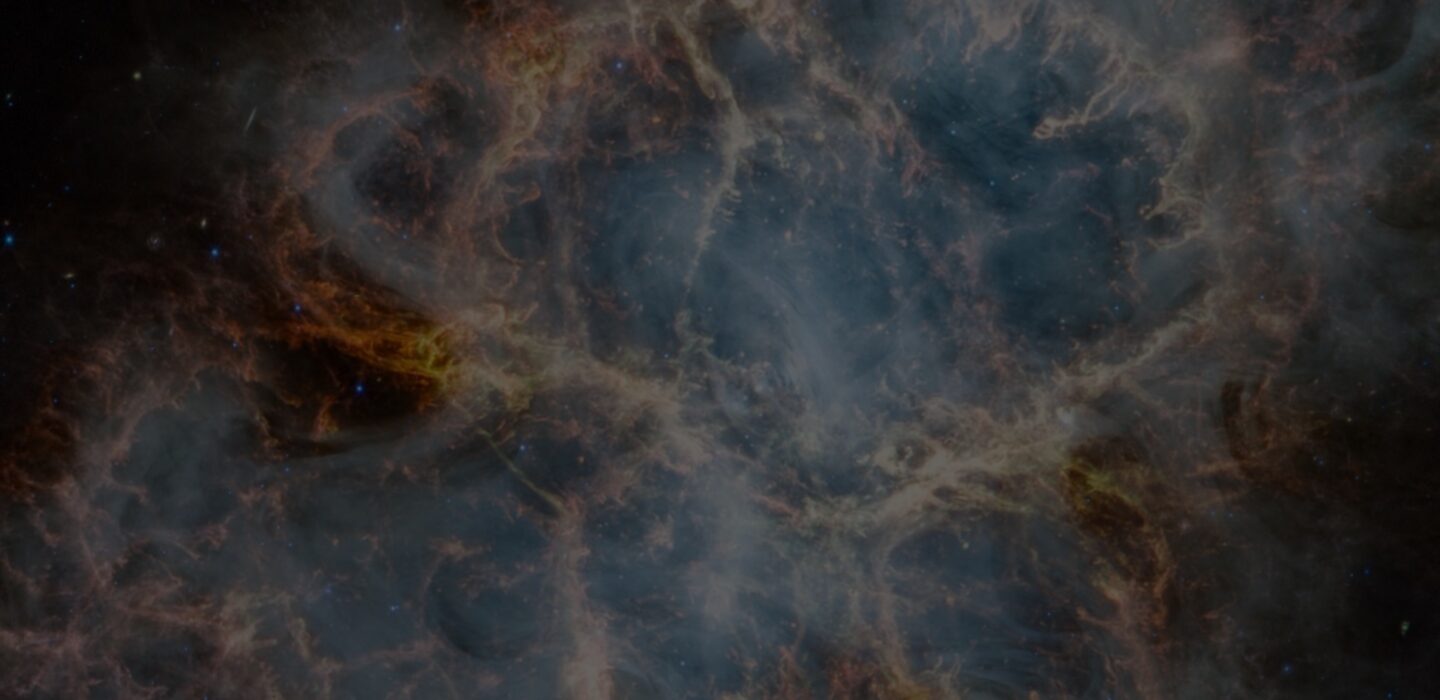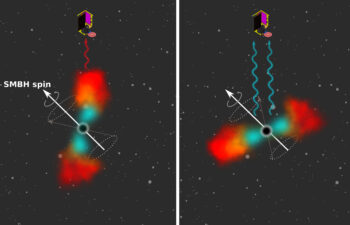Using wobbling stellar material, astronomers measure the spin of a supermassive black hole for the first time
Astronomers at MIT, NASA, and elsewhere have a new way to measure how fast a black hole spins, by using the wobbly aftermath from its stellar feasting.
The method takes advantage of a black hole tidal disruption event — a blazingly bright moment when a black hole exerts tides on a passing star and rips it to shreds. As the star is disrupted by the black hole’s immense tidal forces, half of the star is blown away, while the other half is flung around the black hole, generating an intensely hot accretion disk of rotating stellar material.
The MIT-led team has shown that the wobble of the newly created accretion disk is key to working out the central black hole’s inherent spin.
In a study appearing today in Nature, the astronomers report that they have measured the spin of a nearby supermassive black hole by tracking the pattern of X-ray flashes that the black hole produced immediately following a tidal disruption event. The team followed the flashes over several months and determined that they were likely a signal of a bright-hot accretion disk that wobbled back and forth as it was pushed and pulled by the black hole’s own spin.
By tracking how the disk’s wobble changed over time, the scientists could work out how much the disk was being affected by the black hole’s spin, and in turn, how fast the black hole itself was spinning. Their analysis showed that the black hole was spinning at less than 25 percent the speed of light — relatively slow, as black holes go.
The study’s lead author, MIT Research Scientist Dheeraj “DJ” Pasham, says the new method could be used to gauge the spins of hundreds of black holes in the local universe in the coming years. If scientists can survey the spins of many nearby black holes, they can start to understand how the gravitational giants evolved over the history of the universe.
“By studying several systems in the coming years with this method, astronomers can estimate the overall distribution of black hole spins and understand the longstanding question of how they evolve over time,” says Pasham, who is a member of MIT’s Kavli Institute for Astrophysics and Space Research.
The study’s co-authors include collaborators from a number of institutions, including NASA, Masaryk University in the Czech Republic, the University of Leeds, the University of Syracuse, Tel Aviv University, the Polish Academy of Sciences, and elsewhere.
Shredded heat
Every black hole has an inherent spin that has been shaped by its cosmic encounters over time. If, for instance, a black hole has grown mostly through accretion — brief instances when some material falls onto the disk, this causes the black hole to spin up to quite high speeds. In contrast, if a black hole grows mostly by merging with other black holes, each merger could slow things down as one black hole’s spin meets up against the spin of the other.
As a black hole spins, it drags the surrounding space-time around with it. This drag effect is an example of Lense-Thirring precession, a longstanding theory that describes the ways in which extremely strong gravitational fields, such as those generated by a black hole, can pull on the surrounding space and time. Normally, this effect would not be obvious around black holes, as the massive objects emit no light.
But in recent years, physicists have proposed that, in instances such as during a tidal disruption event, or TDE, scientists might have a chance to track the light from stellar debris as it is dragged around. Then, they might hope to measure the black hole’s spin.
In particular, during a TDE, scientists predict that a star may fall onto a black hole from any direction, generating a disk of white-hot, shredded material that could be tilted, or misaligned, with respect to the black hole’s spin. (Imagine the accretion disk as a tilted donut that is spinning around a donut hole that has its own, separate spin.) As the disk encounters the black hole’s spin, it wobbles as the black hole pulls it into alignment. Eventually, the wobbling subsides as the disk settles into the black hole’s spin. Scientists predicted that a TDE’s wobbling disk should therefore be a measurable signature of the black hole’s spin.
“But the key was to have the right observations,” Pasham says. “The only way you can do this is, as soon as a tidal disruption event goes off, you need to get a telescope to look at this object continuously, for a very long time, so you can probe all kinds of timescales, from minutes to months.”
A high-cadence catch
For the past five years, Pasham has looked for tidal disruption events that are bright enough, and near enough, to quickly follow up and track for signs of Lense-Thirring precession. In February of 2020, he and his colleagues got lucky, with the detection of AT2020ocn, a bright flash, emanating from a galaxy about a billion light years away, that was initially spotted in the optical band by the Zwicky Transient Facility.
From the optical data, the flash appeared to be the first moments following a TDE. Being both bright and relatively close by, Pasham suspected the TDE might be the ideal candidate to look for signs of disk wobbling, and possibly measure the spin of the black hole at the host galaxy’s center. But for that, he would need much more data.
“We needed quick and high-cadence data,” Pasham says. “The key was to catch this early on because this precession, or wobble, should only be present early on. Any later, and the disk would not wobble anymore.”
The team discovered that NASA’s NICER telescope was able to catch the TDE and continuously keep an eye on it over months at a time. NICER — an abbreviation for Neutron star Interior Composition ExploreR — is an X-ray telescope on the International Space Station that measures X-ray radiation around black holes and other extreme gravitational objects.
Pasham and his colleagues looked through NICER’s observations of AT2020ocn over 200 days following the initial detection of the tidal disruption event. They discovered that the event emitted X-rays that appeared to peak every 15 days, for several cycles, before eventually petering out. They interpreted the peaks as times when the TDE’s accretion disk wobbled face-on, emitting X-rays directly toward NICER’s telescope, before wobbling away as it continued to emit X-rays (similar to waving a flashlight toward and away from someone every 15 days).
The researchers took this pattern of wobbling and worked it into the original theory for Lense-Thirring precession. Based on estimates of the black hole’s mass, and that of the disrupted star, they were able to come up with an estimate for the black hole’s spin — less than 25 percent the speed of light.
Their results mark the first time that scientists have used observations of a wobbling disk following a tidal disruption event to estimate the spin of a black hole.
“Black holes are fascinating objects and the flows of material that we see falling onto them can generate some of the most luminous events in the universe,” says study co-author Chris Nixon, associate professor of theoretical physics at the University of Leeds. “While there is a lot we still don’t understand, there are amazing observational facilities that keep surprising us and generating new avenues to explore. This event is one of those surprises.”
As new telescopes such as the Rubin Observatory come online in the coming years, Pasham foresees more opportunities to pin down black hole spins.
“The spin of a supermassive black hole tells you about the history of that black hole,” Pasham says. “Even if a small fraction of those that Rubin captures have this kind of signal, we now have a way to measure the spins of hundreds of TDEs. Then we could make a big statement about how black holes evolve over the age of the universe.”
This research was funded, in part, by NASA and the European Space Agency.

